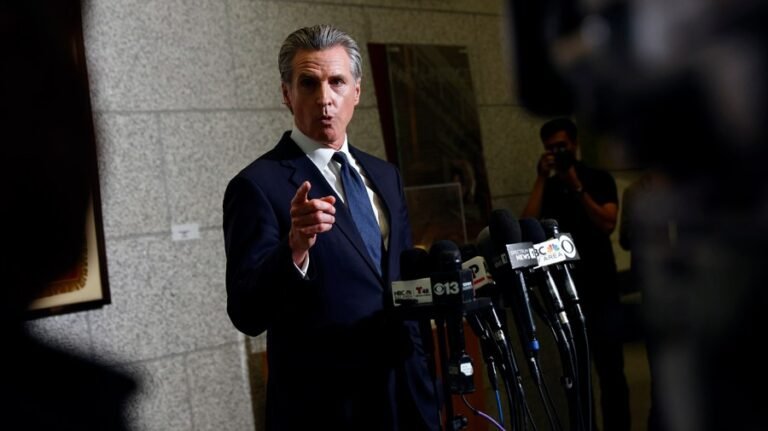President Trump’s push to shift tens of thousands of manufacturing jobs to the U.S. is raising concerns and costs for many American industries, and economists are expressing doubts about its long-term viability.
Some of Trump’s tariffs, which have targeted key manufacturing inputs such steel and aluminum, along with higher U.S. wage levels and a global decline in manufacturing jobs as a share of total employment are all working against Trump’s manufacturing push, and industry sentiment is beginning to wane.
The Empire State Manufacturing Survey released Tuesday by the New York Federal Reserve showed firms turning pessimistic about the economic outlook for the first time since 2022.
Expected business conditions in the survey have sunk since the beginning of the year, with sentiment dropping 20 points during the first week of April and more than 44 points over the last three months.
“Firms expect conditions to worsen in the months ahead, a level of pessimism that has only occurred a handful of times in the history of the survey,” New York Fed economists wrote.
Manufacturing activity across the U.S. contracted in March after expanding in January and February, as measured by the ISM purchasing managers’ index. The contraction resumes a more than two-year downward trend in the sector.
“Production levels in March showed a marked decrease for the first time in 2025, as order books remain weak and new orders continue to decline, causing head-count reductions and lack of capital investment,” Timothy Fiore, chair of ISM’s manufacturing survey committee, wrote in an analysis released earlier this month.
The sort of large-scale expansion in domestic manufacturing that’s being pursued by President Trump requires a lot of capital investment. Businesses are wary of making those investments, citing uncertainty in operating conditions initiated by Trump’s tariff push, which has been delivered in fits and starts.
“Business condition is deteriorating at a fast pace. Tariffs and economic uncertainty are making the current business environment challenging,” one ISM manufacturing survey respondent in the machinery sector said.
There’s little indication so far that companies are planning large-scale reshoring of manufacturing capabilities. This is due largely to increased production costs due to a higher price for domestic labor.
The price of domestically produced manufactured goods like smartphones and electronics could rise.
One 2016 study from MIT Technology Review showed the price of Apple iPhone rising by about $100, or about 13 percent.
Wedbush Securities analyst Dan Ives said earlier this month that the price difference — as distinct from the cost of production — could be more than 300 percent.
“The U.S. tech infrastructure is built with supply chain in Asia. If you like $3,500 iPhones, we should build them in New Jersey. If you like $1,000 iPhones, you build them in China,” he said.
The March small business optimism index from the National Federation of Independent Business noted that “planned capital outlays remain historically low.”
Trump does have some tailwinds in manufacturing investment blowing in his favor.
Construction spending for the manufacturing sector has been shooting through the roof over the last two-and-a-half years as a result of major new industrial policies passed by the Biden administration. They span a $300 billion semiconductor production law, a $500 billion infrastructure law, and a $400 billion renewable energy incentive package.
Manufacturing construction investment hovered between $4 billion and $6 billion per month between the end of the Great Recession and the start of the coronavirus pandemic but skyrocketed up to more than $20 billion by October before starting to subside this year.
However promising these investments appear for the sector, they don’t guarantee that a flood of new jobs is coming to the sector. While Trump has said that “jobs and factories will come roaring back into our country,” administration officials have talked frequently about automation in the context of reshoring manufacturing.
“We are going to replace the armies of millions of people – well, remember, the army of millions and millions of human beings – screwing in little screws to make iPhones,” Commerce Secretary Howard Lutnick said earlier this month. “That kind of thing is going to come to America. It’s going to be automated.”
Treasury Secretary Scott Bessent has argued that reshoring physical production to the U.S., which has a labor force that’s about one-fifth the size of China’s, is conditioned on automation.
“With [artificial intelligence], with automation, with so many of these factories going to be new – they’re going to be smart factories – I think we’ve got all the labor force we need,” he said this month.
Restoring manufacturing as a share of total employment would reverse decades-long labor trends — both in the U.S. and globally. As a portion of total employees who don’t work on farms, factory workers have steadily declined from nearly 40 percent of the workforce in 1944 down to just 8 percent in March of this year.
Steven Davis, research director at the Hoover Institution and one of the foremost authorities on job creation and job loss in the manufacturing sector, told The Hill that the interest in a manufacturing revival is driven by a “fetish.”
“There’s a fetish for manufacturing jobs,” he said. “I understand that there are some people who once had manufacturing jobs who’d be happy to go back to them – that’s certainly true. But the American workforce as a whole would rather have an office job that often pays more than a manufacturing job.”
Data from the International Labour Organisation and the World Bank shows that manufacturing jobs as a share of total employment has been declining at the international level as well, with downward trends across majority economies including France, Germany, Japan and the United Kingdom. Some data sources even show a downward trend in export-focused China.
The decline is due to productivity growth in the sector attributable to integrated technology and higher capital-to-labor ratios, Davis told The Hill.
“Manufacturing is going the same way as the agricultural sector did a half-century earlier,” he said. “Those long-term trends are not going to be reversed by trade policy.”


